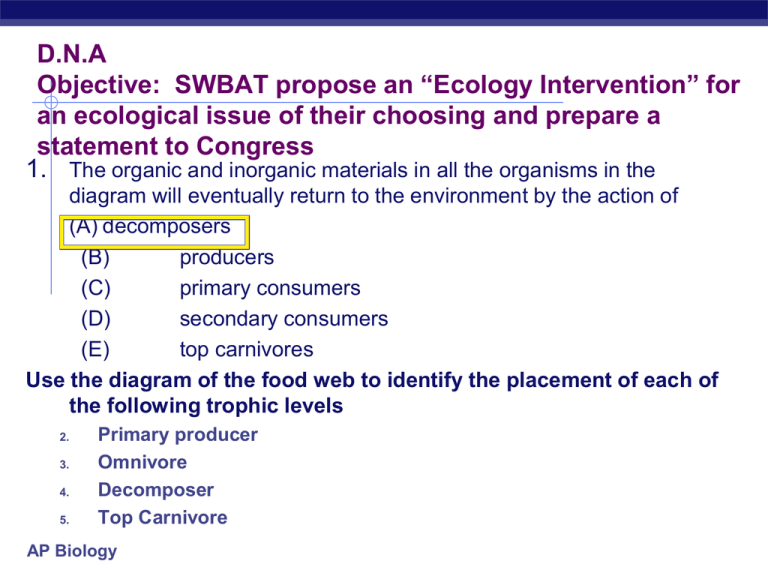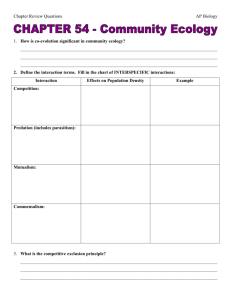Community_Ecosystems
advertisement

D.N.A Objective: SWBAT propose an “Ecology Intervention” for an ecological issue of their choosing and prepare a statement to Congress 1. The organic and inorganic materials in all the organisms in the diagram will eventually return to the environment by the action of (A) decomposers (B) producers (C) primary consumers (D) secondary consumers (E) top carnivores Use the diagram of the food web to identify the placement of each of the following trophic levels 2. 3. 4. 5. Primary producer Omnivore Decomposer Top Carnivore AP Biology D.N.A Objective: SWBAT explain the relationship between species richness, equability, and diversity. 1. An overlap in the niches of two species will most frequently result in (A) (B) (C) (D) (E) interspecific cooperation a hybridization of species a mutualistic symbiotic relationship an increase in the biomass interspecific competition 2. Competitive exclusion is most likely to occur between two (A) (B) (C) (D) (E) AP Biology closely related species occupying different niches closely related species occupying the same niche related species occupying different habitats unrelated species occupying different niches populations of the same species organism population Community Ecology community ecosystem biosphere AP Biology Community Ecology Community all the organisms that live together in a place interactions Community Ecology AP Biology study of interactions among all populations in a common environment To answer: In what way do the populations interact? Four key characteristics of a community 1. Species diversity 2. Dominant species 3. Response to disturbances 4. Trophic structure AP Biology Niche An organism’s niche is its ecological role habitat = address vs. niche = job High tide Competitive Exclusion If Species 2 is removed, then Species 1 will occupy Low tide whole tidal zone. But at lower depths Species 2 out-competes Species 1, excluding it from its potential (fundamental) niche. AP Biology Species 1 Chthamalus sp. Species 2 Fundamental Realized niches niches Semibalanus sp. Niche & competition Competitive Exclusion AP Biology No two similar species can occupy the same niche at the same time Interspecific interactions Symbiotic interactions competition (-/-) compete for limited resource competitive exclusion! predation / parasitism (-/+) mutualism (+/+) lichens (algae & fungus) commensalism (+/0) barnacles attached to whale AP Biology Mutualism OPEN WIDE: A cleaner shrimp reaches into a moray eel's mouth. The shrimp uses its claws to pick stuff off the eel's body. That can include dead skin, tiny pieces of food, and even little creatures that can hurt the fish. AP Biology Mutualism Example 2: Bats get food from the flower. Seeds come out in bat poop. AP Biology More examples of Commensalism Clownfish hide in poisonous sea anemones which protect them from larger fish. The clownfish benefit, and nothing happens to the sea anemones. AP Biology Parasitism Female mosquito feasting on human blood. AP Biology Predation drives evolution Predators adaptations locate & subdue prey Prey adaptations elude & defend Predation provides horns, speed, coloration a strong selection pressure on both prey & predator spines, thorns, toxins AP Biology Anti-predator adaptations Hide from predators avoid detection camouflage Warn predators advertise how undesirable you are as prey aposematic coloration apo = away & sematic = sign/meaning Batesian mimicry Mullerian mimicry AP Biology Defense mechanisms Camouflage cryptic coloration whipporwill frog lizard lizard AP Biology toad Convergent evolution Mimicry Batesian mimicry palatable or harmless species mimics a harmful model green parrot snake hawkmoth larvae AP Biology Hawkmoth larva puffs up to look like poisonous snake Convergent evolution Batesian mimicry Monarch male Viceroy male poisonous edible Which is the moth bee? fly vs.vs. thethe bee? AP Biology fly bee moth bee Mullerian mimicry two or more protected species look like each other Mullerian mimicry - group defense? - predators may evolve innate avoidance AP Biology Common warning coloration Aposematic species come to resemble each other black, red, orange & yellow means: DON’T EAT ME! AP Biology Coral snake is poisonous King snake is not Red on yellow, poison fellow; red on black, safe from attack AP Biology Species diversity greater diversity = greater stability Greater biodiversity offers: more food resources more habitats more resilience in face of environmental change AP Biology



